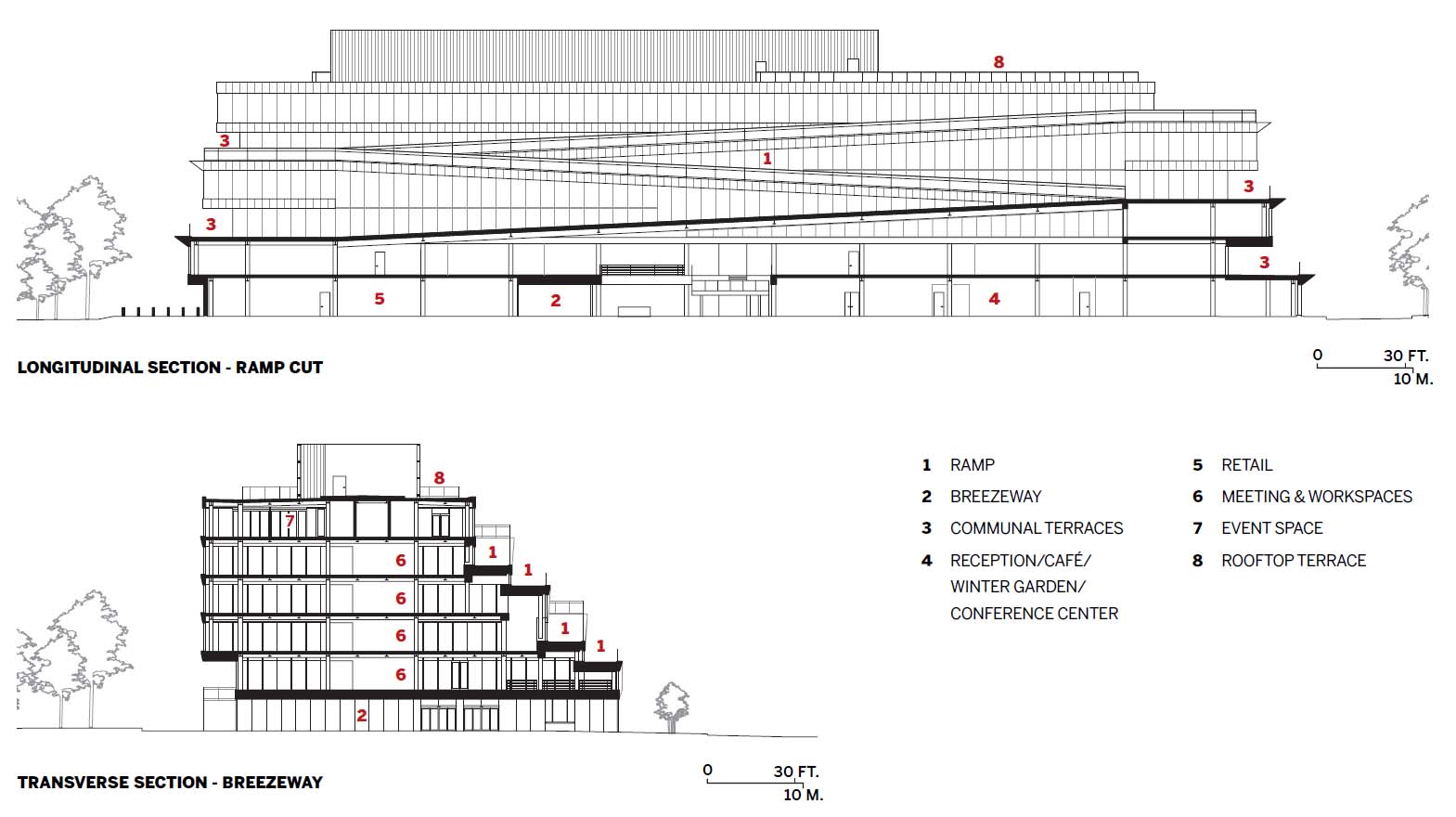The fact that Ledger, the “world’s first” bikeable building, was completed in late 2022 in the small Arkansas city of Bentonville—and not Copenhagen, Boulder, Portland (Oregon), or a Dutch university town—is ultimately the least surprising thing about it.
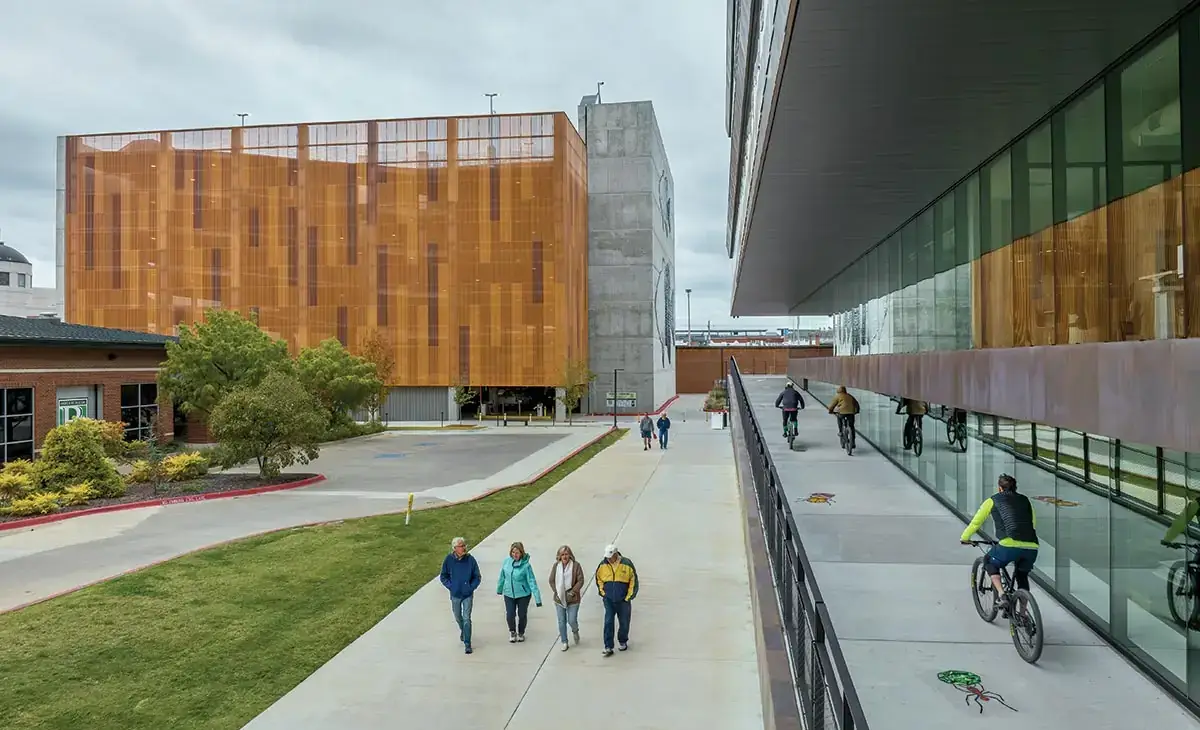
The six-story building has a ramp for cyclists and pedestrians built into its east side, with large terraces flanking its north and south ends. Photo © Timothy Hursley, click to enlarge.
Located two blocks south of Bentonville’s downtown square, the defining feature of the 230,000-square-foot coworking and event complex is a switchback ramp that zigzags up the entire length of its eastern facade, carrying cyclists and pedestrians at an incline under 5 percent from a street-grid-connected breezeway to a rooftop terrace. Publicly accessible, it’s an easy ¾ of a mile to the top and back down. This flashy new arrival in the birthplace of Walmart was set to debut as a WeWork project—the company’s first foray in the Natural State—during the short-lived reign of inaugural chief architect Bjarke Ingels. That fizzled out with the 2019 collapse of the office-sharing giant. Realized instead as more of a multifaceted community anchor than a straightforward mixed-use commercial building, Ledger is a bellwether project of sorts: an early entry in the transformation of Bentonville from sleepy company town to a 21st-century hub for innovation and commerce befitting the retail mega-corporation that calls it home. Bentonville’s growth is evidenced by the multiple construction cranes throughout town, including those at the sites of two new hotels going up just down the road from Ledger and, farther out, at Walmart’s under-construction 350-acre flagship campus and at the Crystal Bridges Museum of American Art, which is undergoing a major expansion. Fittingly, the best views of Bentonville’s shifting landscape can be had from 66 feet above the street on the sixth-floor patio of Ledger, a building—now Bentonville’s tallest at six stories—that manages to look both completely out of place and right at home in a small town on the cusp of big change.
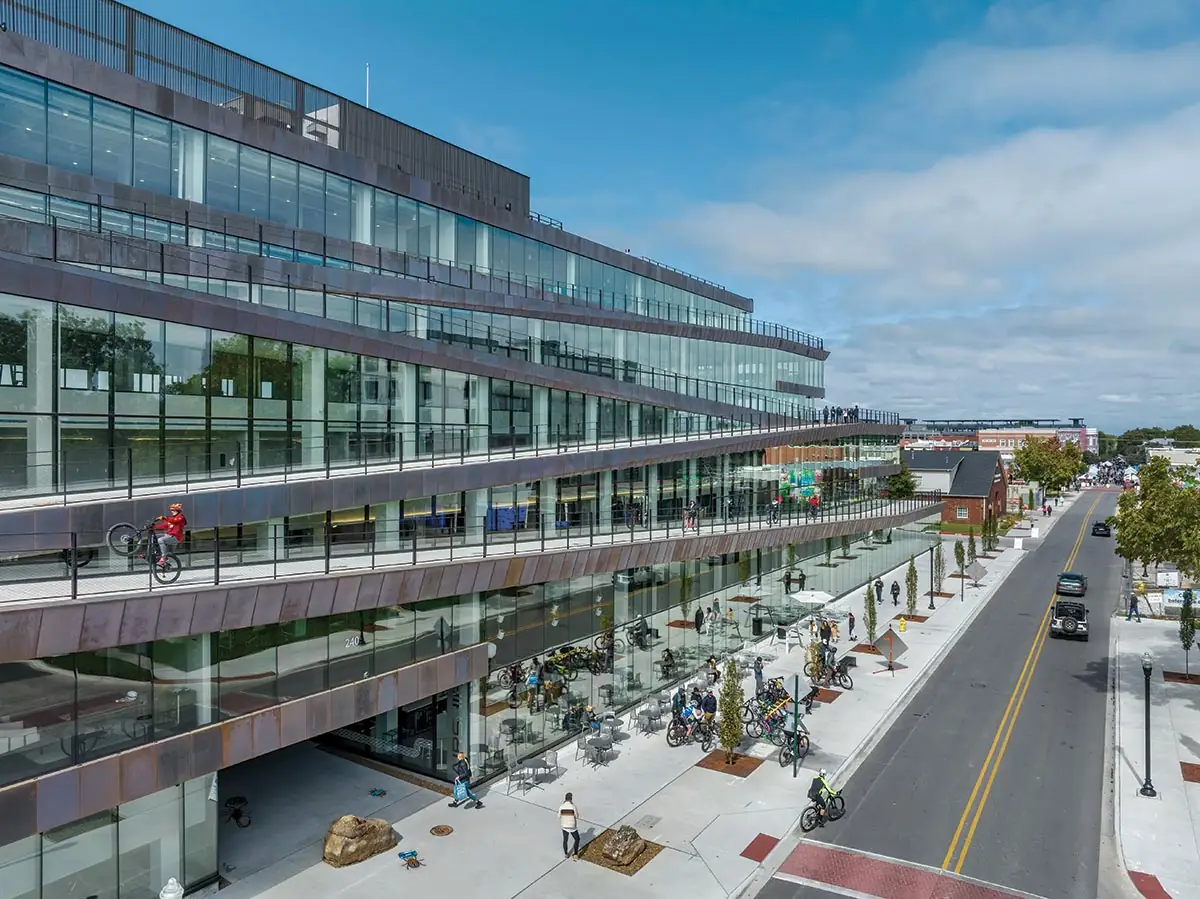
Rising above S. Main Street, Ledger steps back with each ramp level to create urban massing. Photo © Timothy Hursley
A long rectangular volume framed in steel, sheathed in glass, and clad with patinated-copper panels, Ledger’s design is the intitial result of a collaborative effort between Marlon Blackwell Architects, based in nearby Fayetteville, and WeWork’s Ground Up Studio. During its relatively brief existence, the studio was led by WeWork’s then senior vice president of architecture Michel Rojkind; fellow team members included vice-president Christian Callaghan and design director Haruka Horiuchi. After WeWork’s exit from the project, Rojkind, Callaghan, and Horiuchi saw it through to completion for clients City Center, Kyleton Development, and Walton family–backed Blue Crane. Mexico City–based Rojkind, Callaghan Horiuchi (the duo’s post-WeWork practice), and Marlon Blackwell Architects all share credit as design architect for the core and shell construction phase; Callaghan Horiuchi also serves as interior design architect and design manager.
“This is the sum of our parts,” says Rojkind. “When we started working, the first thing that we put on the table was that the building doesn’t belong to any one of us—it’s not a Marlon Blackwell building or a Michel Rojkind Arquitectos building. This is a building that’s going to belong to Bentonville, and so it has to look like a building for Bentonville.”
Ledger’s communal-terrace-interspersed bike ramp, envisioned as an extension of the street that activates the entire exterior of the building for pedestrians beyond the ground level, is very much of Bentonville. In 2020, city leaders proclaimed it “mountain-biking capital of the world” to draw attention to its robust infrastructure for that purpose that includes more than 150 miles of trails in the city, linking to a larger regional network weaving throughout the rolling foothills of the Ozarks. (As with many aspects of life in the northwest corner of Arkansas, the region’s mountain-biking credentials have benefited from the largesse of Bentonville’s most prominent family, the Waltons.) As Rojkind notes, because of the building’s imposing size, it ran the risk of being “super-bulky and awful,” but the ramp acts to “push the building back, to make it be more at ease with the existing houses around it.”
The 1,900-foot-long concrete-paved ramp that forms the stepped eastern facade of the building is akin to a series of stacked stairs, with each section of the ramp serving as the roof for the level directly below it. “It’s one of my favorite things about the building—when you’re on the ramp, you see the level that you’re on and the next one down, but that’s it,” says Horiuchi. And, because the building is glazed, ramp-users can see in along most of the route: this blurring of interior and exterior spaces lends Ledger an almost-voyeuristic fishbowl quality. (The more private western side of the building, which faces a small city park, does not feature a setback.)
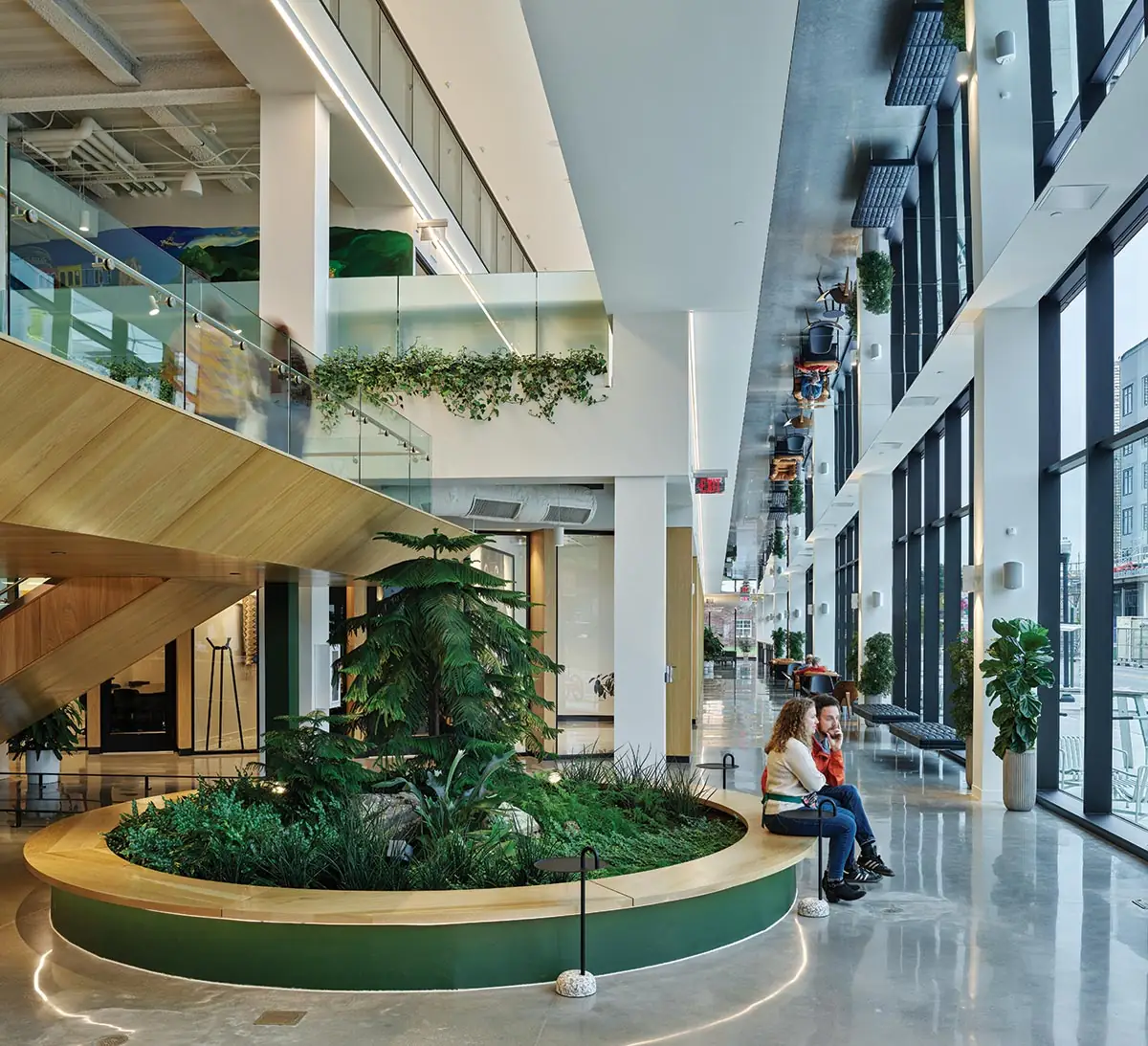
1
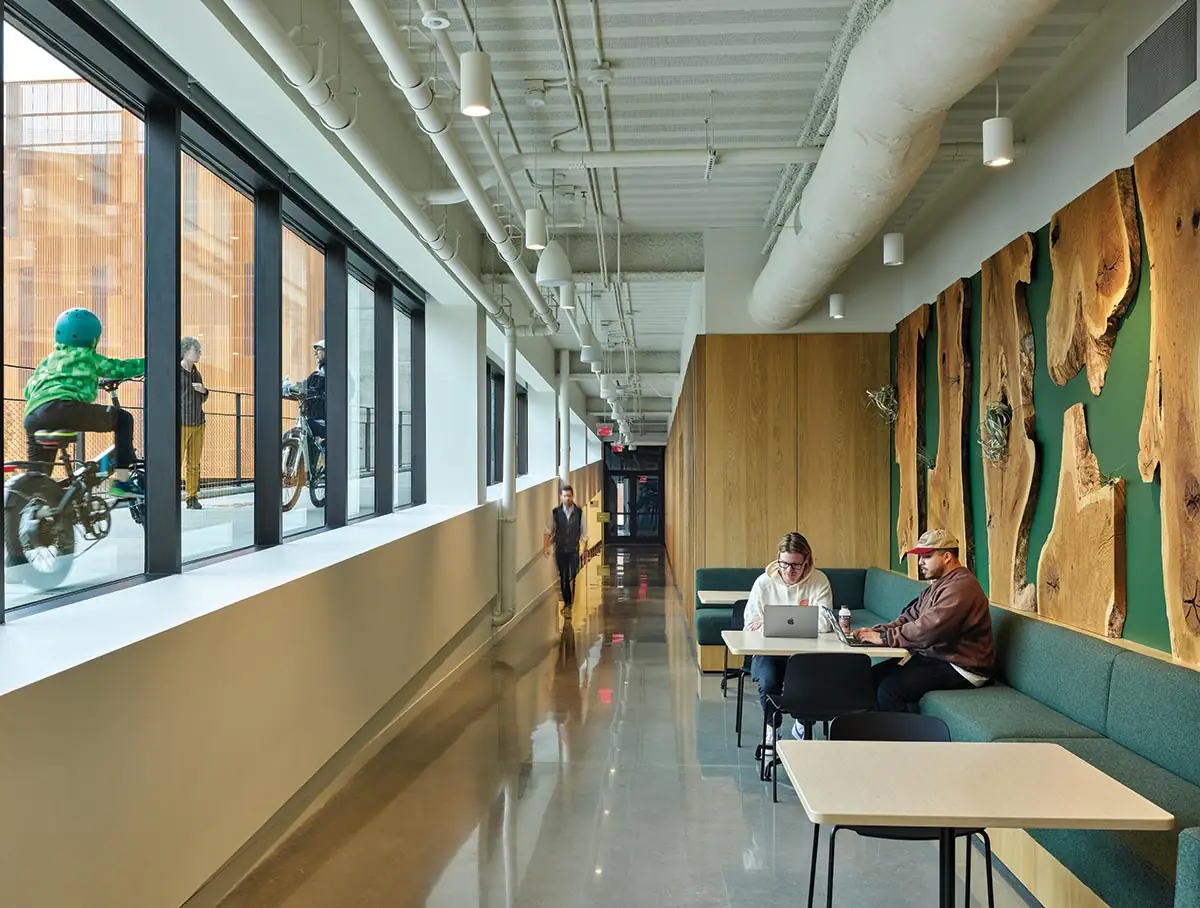
2
Interior spaces, including the lobby (1) and common areas (2), look out to the street and ramp. Photos © Timothy Hursley
In addition to the novelty of being able to pedal one’s way straight from a trail to an upper-floor terrace that provides direct access to a work or event space, Ledger boasts myriad cyclist-friendly amenities that are exclusive to coworking members, including secure bike storage, lockers and changing facilities, e-bike charging stations, and an “experience center” operated by high-end bike manufacturer Specialized on the ground floor. Yet not everyone is rolling in on two wheels to the building’s mix of coworking spaces, reservable meeting and event rooms, and private offices—the presence of a detached eight-level parking garage, featuring a “fishy” large-scale kinetic art installation by Stefan Sagmeister, is a reminder that we’re still in Arkansas, not Amsterdam.
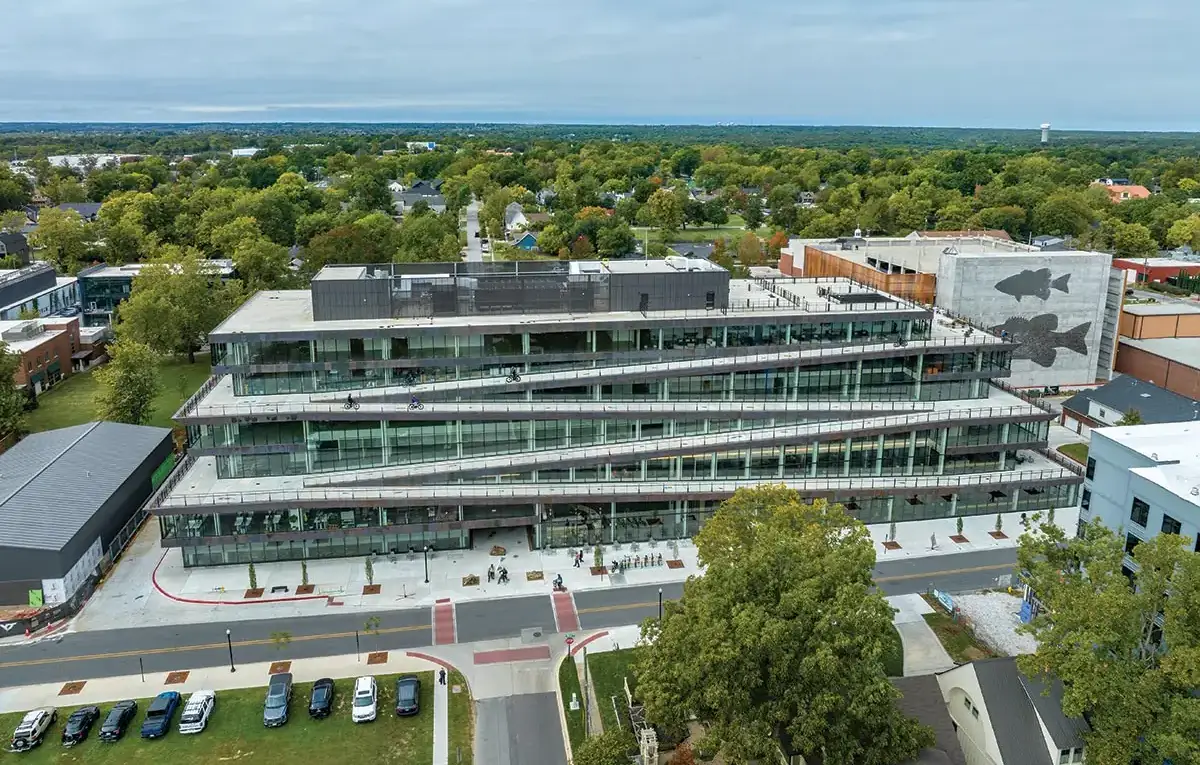
An installation by the graphic designer Stefan Sagmeister can be found on the east facade of the parking structure. Photo © Timothy Hursley

Depicting regional insects, Stefan Sagmeister’s glass mosaics begin within the breezeway and travel up the ramp. Photo © Timothy Hursley
While Ledger’s embrace of Bentonville’s cycling culture takes the bike-to-work concept to a literally new level, the building’s most impressive function is that of a vertical linear park. By permitting public access to the building’s ramp and outdoor terraces during “recreation hours,” from sunrise to sunset, Ledger has been adopted as an all-purpose hangout space for the Bentonville community. When I visited last fall, there were only a handful of cyclists zipping up and down the side of the building. At 12½ feet wide, the ramp is easy enough to navigate for more casual cyclists (and an assist from the added thrust of an e-bike, which can be borrowed on-site, certainly made the trek less taxing). But apparent in greater numbers were teenagers socializing and snapping selfies on the terraces, neighborhood residents walking their dogs, senior citizens enjoying late-afternoon strolls, and visitors taking in another major installation by Sagmeister, Now is Better, Bentonville, a series of 95 glass-mosaic insects embedded in the concrete along the full length of the ramp.
“It was the cherry on the cake for the ramp, which already has this generosity of the street going up the building,” says Rojkind of Sagmeister’s work. Public art, curated by local arts and culture nonprofit CACHE, is found throughout the building’s interior, including the public lobby with its coffee bar and greenery-infused winter garden and extending to the members-only workspaces and meeting rooms; each of Ledger’s bookable spaces is home to a signature piece of art.
Thoughtful and playful in equal measure, the design of Ledger is the result of egos’ being set aside and collaboration taking the front seat. Seemingly a surprise, it’s a building that, at this moment, wouldn’t make sense anywhere but Bentonville.
Click drawing to enlarge
